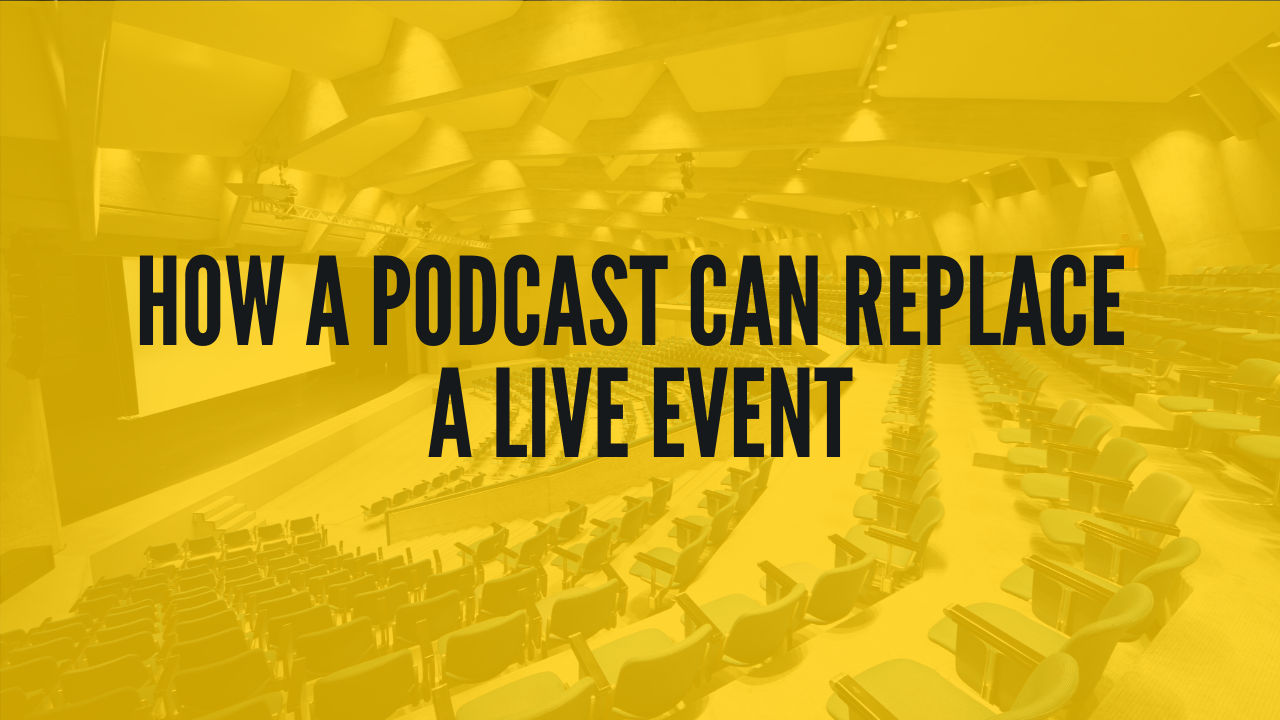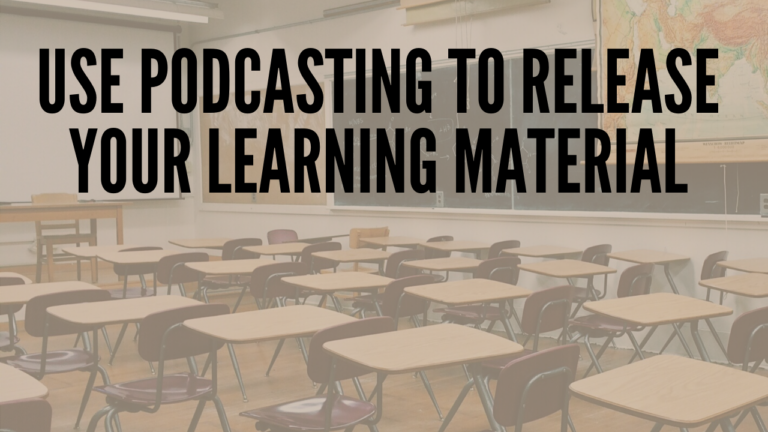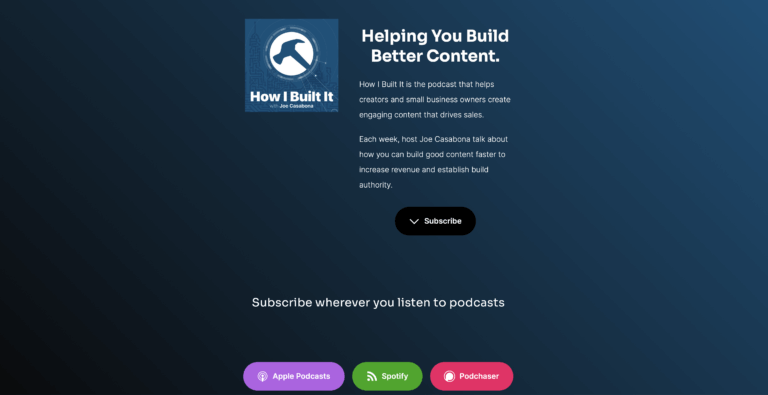How A Podcast Can Replace A Live Event
Events are some of the best ways to learn, network, and engage with a community of people. With most in-person events being cancelled for the foreseeable future, we’re looking for a replacement – someplace to learn, grow, and meet new people.
Virtual Events seems to be the most popular, and they’re fantastic! But they also take a lot of work. Replacing, or at least supplementing, your event with a podcast could be a big, long-lasting win for you, your speakers, your sponsors, and especially your attendees.
Benefits of Making Your Event a Podcast
OK so before we start brainstorming ideas on how to do it, let’s talk about why it might be a good idea. First and foremost, it’s a lot less work. It’s likely not going to be live at all, and you don’t need to manage a control room for bringing on guests, taking comments and questions, and falling victim to technical glitches.
Speakers can focus on delivering good content without worrying about also managing the camera or slides. All they’ll need to do is talk. You can still mention sponsors at the beginning and end of the talk. And you can encourage engagement in a community area you set up for the event (forums, Slack, Discord, Facebook). So there are a few benefits. But how would you structure such a podcast? Let’s dive into that.
Note: I know what you’re thinking already…sure there are some benefits, but you lose a lot…like email opt-ins, real time engagement, live demos, etc. That is definitely true and this method isn’t for everyone. But you can still use some of these ideas to supplement, and even promote your virtual event.
Planning Your Content
When it comes to planning your content, it all depends on how you want to position the podcast; is it replacing or promoting the event? That will help you determine the schedule for episodes, and how often you want to put them out. We’ll run through a few examples soon but first, I want to give you some ideas for the show:
- Release the talks as episodes – 1 each
- Conduct speaker interviews about their talks and other areas
- Do behind the scenes (BTS) episodes describing what planning the event is like
- Have event sponsor-only episodes where they get to provide value and knowledge. Help your audience get to know the sponsors since there’s no booth!
This type of content will help people connect with your event, even though they aren’t there in person. Speaker interviews will form a better both between audience and speakers by helping your audience get to know the speakers.
A podcast for your event gives you the chance to invite attendees behind the scenes. Click To TweetBTS episodes will show attendees (and sponsors) how much effort still goes into organizing a virtual event…it’s more than just pushing a few buttons! You can talk about your tech stack, gear, how you’re managing speakers and talks, the community, and what it’s been like to pivot from in-person to virtual. And with sponsor-focused episodes, you can dig into who your sponsors are and how they’re providing value to the audience, special offers, and how to get in touch.
The goal for these episodes is to make sure they aren’t an episode-long pitch. Pick a topic the sponsor specializes in, talk about it, and then do the pitch!
Scheduling Your Episodes
All right! Now back to that question: is this promoting or replacing the event?
If you’re promoting, I recommend starting 3–4 months before the event. Introduce the event, then alternate between speaker interviews, BTS episodes, and sponsor spots. You can continue these sort of posts after the event is over too! During the week of the event, you can do something like release the talk the day (or week) after it’s given.
You can build buzz and promote your event with a podcast that gets people excited for the upcoming talks. Click To TweetIf you’re replacing your event, there’s some nuanced changes you can make. I’d still start a couple of months before the event was supposed to be, like above. But I’d also make a big deal every episode of “the event week.” During the event week, you can release 1–2 talks per day into the feed.
You’ll want to have some special CTAs in these episodes based on what we talk about below, for engaging and collecting information. But you’ll also want to space them out a bit to give people time to listen, digest, and write in with the clear instructions you give them. After event week, you can continue the conversation and answer questions asked during the talk, recap how it went, and release more BTS content.

Learn how podcast pros produce their shows…
…and how you can improve yours.
One breakdown, delivered to your inbox weekly.
Learn the tools and processes used by top podcasters and reclaim hours of your life every week.
Engaging with the Audience
One of the hardest parts of doing anything online vs. in-person is getting the same level of engagement. If you’re not going to host your event traditionally, there are a few options. The goals are to make how to engage super clear, with a low barrier for entry. Balancing that low barrier with a good way to get everyone in place can be tough.
Creating a community for your event-based podcast is SO important. It will be where attendees network! Click To Tweet- Slack/Discord: You can set up a Slack channel or Discord for people to chat in real time. You can even set up different channels as tracks or rooms. Then, as each talk comes you, you can set the topic in those channels to gather questions about the currently released talk…you could also set a channel per room, but that seems like a bit too much to manage if you have lots of talks.
- Forums: I’ve seen forums used successfully for podcasts, though this might be a tough sell depending on the audience. Still, you can create different discussion boards for each talk, as well as a few for sponsors and a “hallway” track.
- Chatbot or Online Form: This is much less interactive, but if you’re just looking for a way to get questions from listeners, this might be a good way to go.
- Facebook: This might be my least favorite solution, but it is a place where lots of people hang out. You can create a new post for each talk (and pin it to the top to make sure people see it). But still, it’s someone else’s playground and the organization is lacking.
Collecting Information
Now there is one big question you’re faced with if you’re offering this content on a podcast: how do people “sign up” and how do you communicate with attendees. There are two real options for you to check out.
Opt-in for Bonus Material
First, you can try an opt-in that’s your CTA at the beginning and end of each episode. Offer slide, digital swag, and bonus material for signing up. This is not a fool-proof plan as people will still be able to consume the content for free. But you are getting more high quality leads that way as the people who are willing to opt-in are better candidates for your other stuff.
Private Event Feed
You can make the “week of” event and/or talk episodes private. Hosts like Castos offer this functionality. You can have a private feed that you share with “attendees.” So you can have the main feed, which you use for promotional stuff, and the private feed, where you event takes place. This is where you can promote the community as well.
If you absolutely need people to sign up for your event, you can always have a private feed. Click To TweetIf you absolutely want everyone to sign up to hear your event content, then a private feed is the only way to go.
An Alternative Consideration for Your Event
This route won’t be for everyone. But if you have a bunch of content you want to put out in the world and a digital summit seems daunting, this could be a great alternative. You’ll have the ability to reach an audience, and do even more for your sponsors and speakers. It’s also a fantastic way to promote your events!
I’d love to hear your thoughts! Let me know in the comments below.







